| |
SpaceX Starlink 4-3 Launch
12/02/2021. I had great hopes for this launch, but they really didn't work out. Haze, smoke, a trajectory that stayed just below the last light of day, a plume front-illuminated rather than back-lit, all combined to produce a muted light show.
I shot it with the 85mm F1.4 Rokinon on the Canon R6, opting for a relatively low ISO, shorter exposures, and a little less image scale compared to last time to try to get a crisper image of the rocket. When the plume failed to light up in twilight as hoped, I was left with a lot of underexposed frames. While scrolling through them, it occured to me that they looked a lot like deep-sky photos before refining.
In the end, I treated the rocket and its plume like a comet. I picked one sharp image with the rocket well placed, then aligned all the images on the head of the "comet." Then I aligned the same images on the foreground trees and finally aligned several images near the chosen base image on the stars. I stretched and denoisified each layer as needed, and finally I blended them all back together. More notes in the morning; tonight, I leave it here:
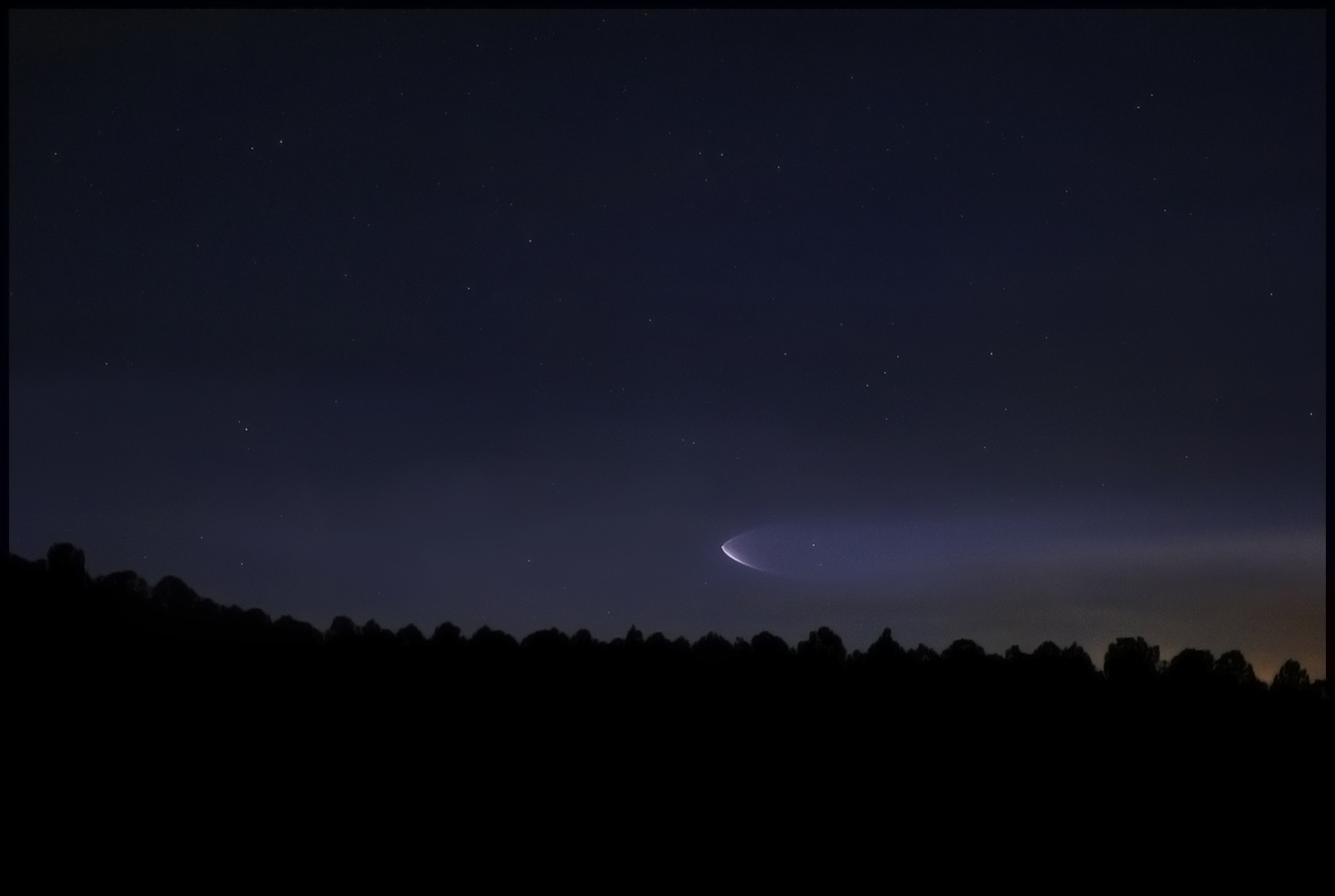
SpaceX launching Starlink satellites, viewed from Rutherford College, NC.
Make it big. Good Lord, just click the pic.
I went to a lot of trouble. That's the least you can do.
That's 28, 1/15s exposures at F1.4 and ISO 3200, aligned as described in the diabolical master plan just above. And to all a good night!
Comes now the morning after. I wasn't surprised to pull out the extended plume — it had to be there. I was surprised by its delicate blue color. I expected it to be reddened in the light of orbital sunset, but it turns out that by this stage in the flight, the plume was lit mainly by the blue curve of the horizon. Here's the view from the rocket looking back our way at about the same time I was photographing it from below. The color of the horizon in this view is the color of the plume in my photo:
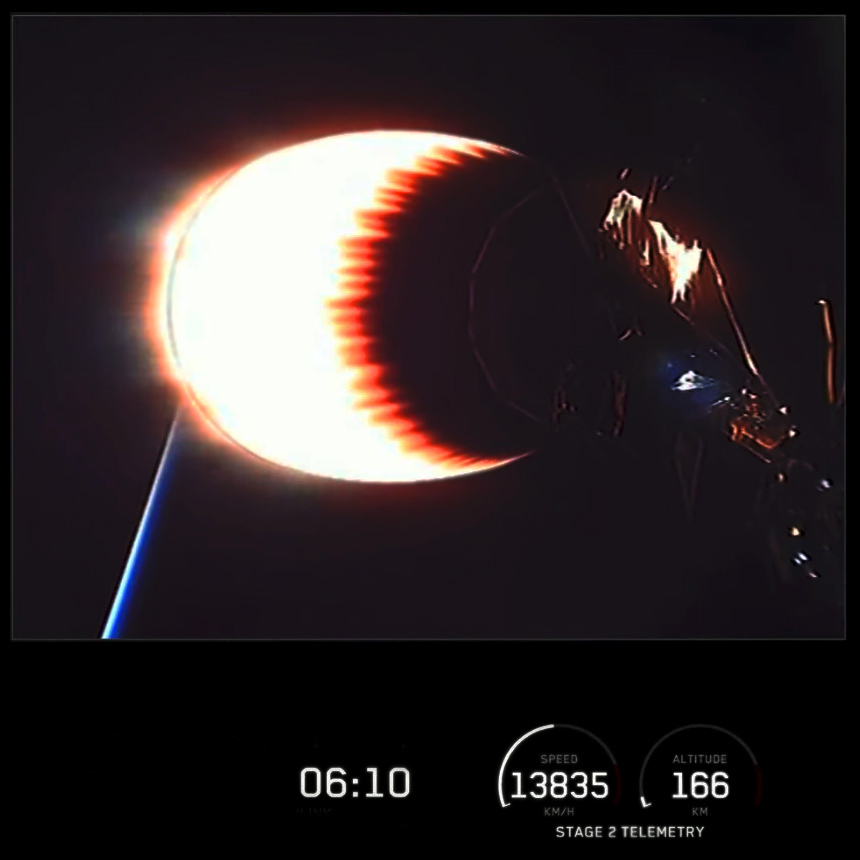
SpaceX Web Broadcast Screen Capture
That explains the blue light in the "tail." The orange glow at lower right is either the last light of sunset on distant clouds (we're pulling up some very faint stuff in these images) or the glow of streetlights in Hickory, the main part of which is farther south. There have also been some wildfires over thataway in the state, but the large fire at Pilot Mountain is considerably north of this sight-line.
12/03/2021. Twenty-five hours later, the payload of Starlink satellites sailed over in deep twilight, gliding through Lyra into Draco and into orbital night. I'll get some video up soon. For now, you get these two still efforts. Click 'em to make 'em big.
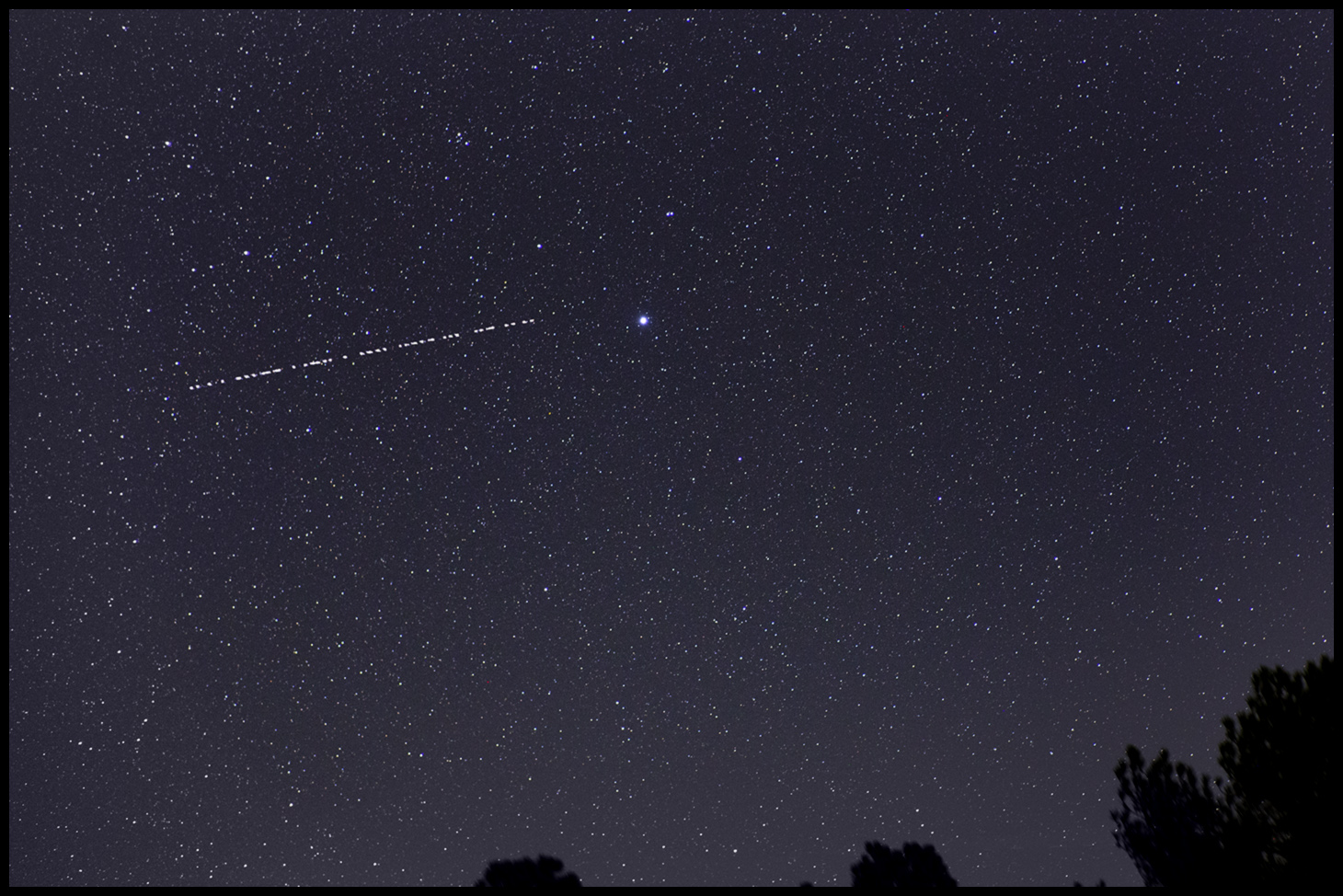
That's a complicated production. The train I videoed in 4k, 1/10s exposures at F1.4 and ISO 12,800 behind a 105mm lens. The starfield I shot a couple of minutes later, 30s at F2.8 and ISO 1600 with an 85mm lens. Then I pulled 16 frames from the video into Photoshop, aligned on the satellites, averaged the frames, deconvolved to remove motion blur, adjusted for the different frame sizes and focal lengths, and mapped the train back into the starfield. It looks about right — the warm tone of the sunlit satellites against the sky and beside blue-white Vega — but I need to re-check whether I got all the transforms right. I might have shrunk when I ought to have enlarged or vice versa.
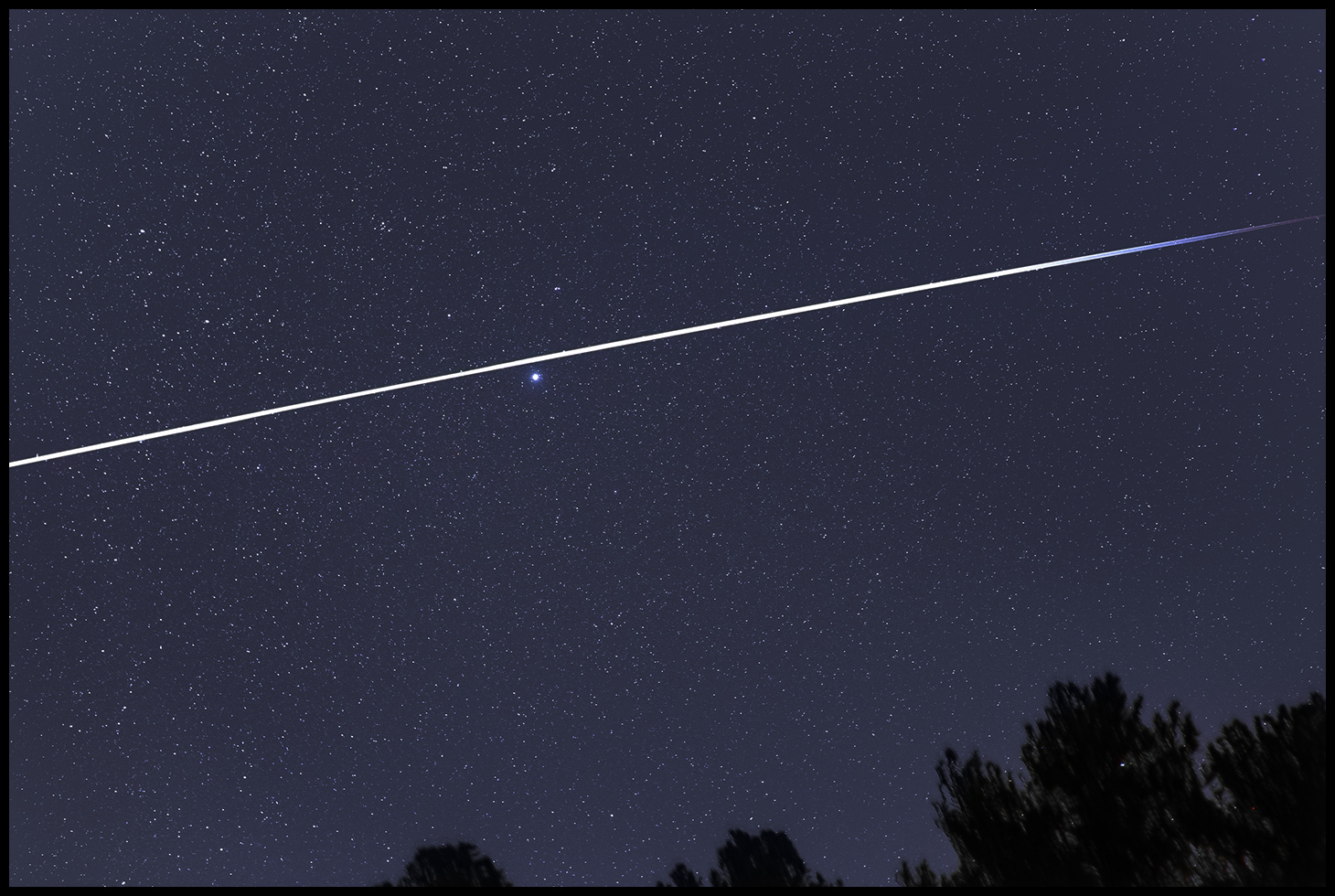
Two frames stacked with the 85mm carried on an original model iOptron SkyTracker. Thirty seconds at F2.8 and ISO 1,600 (times two) as the satellites sailed into the shadow of the Earth. That blue hue near the right edge of the frame should begin to look familiar by now.
Later that same night, here's the video:
12/04/2021. The next night, the Starlink satellites passed through Cygnus. I videoed this pass using the R6 and the 24mm Rokinon I've been trying to adjust despite unanimous intertube advice that the only thing to be tried is shimming. (It is minimally shimmed, but today I took the rear element stack out using a new tool then cleaned and reseated those elements. Is it better? Maybe. Anyway, it looks good for video. We'll see about more demanding applications soon. It may yet be a keeper.)
Watch on Vimeo
24mm F1.4 Rokinon on Canon R6
1/40s, 24fps, ISO 25,600
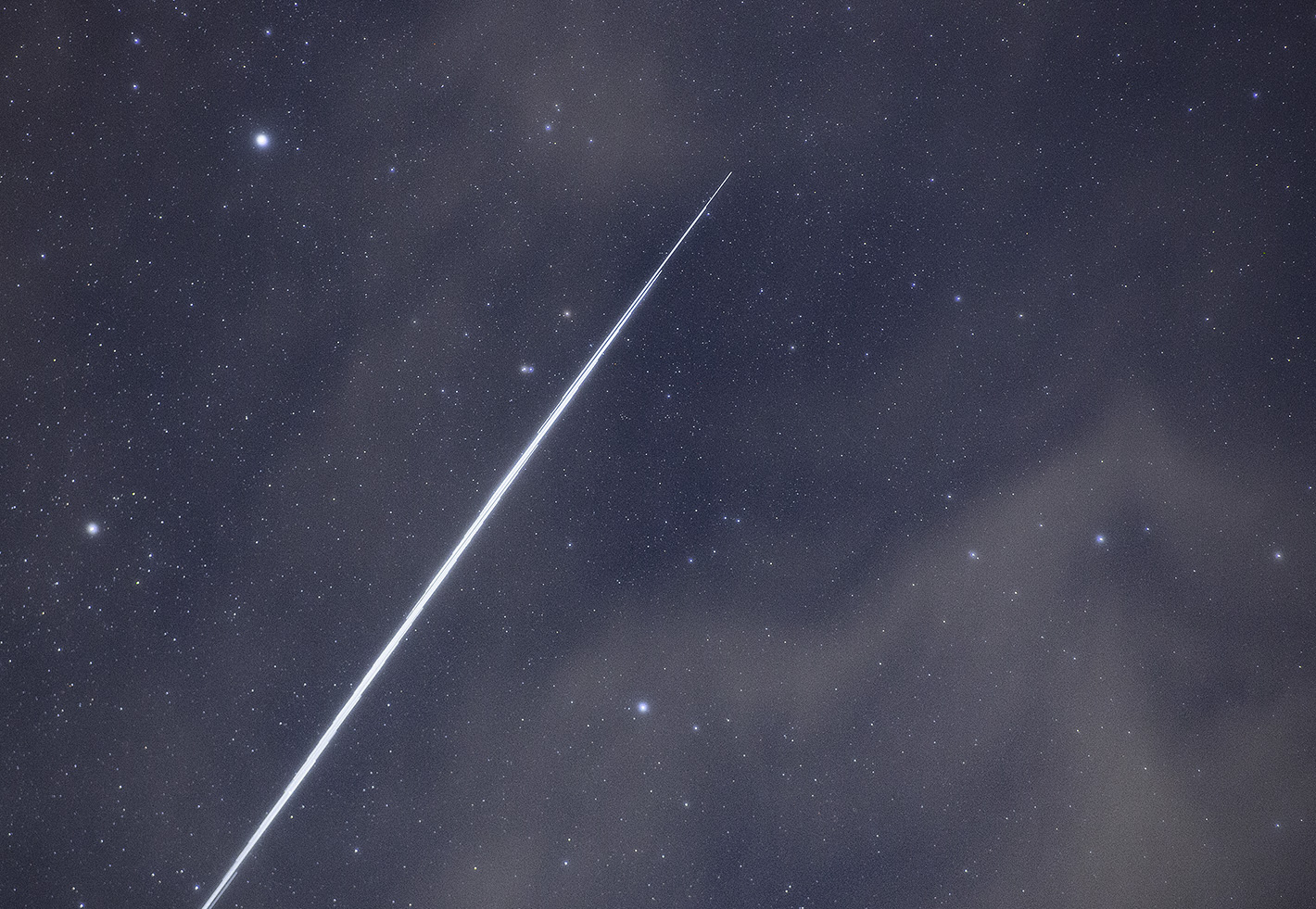
85mm F1.4 Rokinon on Canon 6D
Tracked on iOpton SkyTracker
10s, F2.0 at ISO 1,600
That's Deneb at upper left, Sadr at left, and the west wing of Cygnus extending toward the right side of the frame.
12/05/2021. There was a pass tonight in bright twilight as these newest Starlink satellites sailed almost directly overhead, then down the northeastern sky between Alpha Cas and M31. I was ready, the sky looked great one hour ahead of time, and then it didn't. I'll spare you the timelapse of the clouds rolling in and shutting down the sky. It is a depressing sight. I let the 24mm go, just in case something snuck through the clouds. Nothing did. Tuesday, we'll get a much more distant pass in the far north, but the chain by then will take several minutes to parade by any given point, and the satellites will be down around 5th magnitude. The show put on by the class of December 2 is pretty much done.
:: top ::
My deep-sky photos are made with a variety of sensors and optics. Deepest images come now from a ZWO ASI1600MM Cooled Pro CMOS camera, an ASIair (model 1) and sometimes one of several laptops. A good many images come from an unmodded Canon 6D but a lot more will be coming from an R6. Video and video extracts begin in a Canon EOS M, usually running in crop mode via Magic Lantern firmware (but the 6D and especially the R6 will probably see more use). Telescopes include an AT10RC, an Orion 10" F4 Newtonian, and a pair of apochromats: a TMB92SS and a AT65EDQ. A very early Astro-Physics 5" F6 gets some use, too. So do lots of camera lenses on both the ASI1600 and on the Canons. A solar Frankenscope made using a 90mm F10 Orion achromat and the etalon, relay optics, and focuser from a Lunt 60 feeding a small ZWO camera will see more action as the Sun comes back to life (Autostakkart!3 is my current fav for image stacking). Mounts include an iOpton SkyTracker (original model), a bargain LXD-55, a Losmandy G11 (492 Digital Drive), and an Astro-Physics Mach1. PixInsight does most of the heavy lifting; Photoshop polishes. Some of the toys are more or less permanently based in New Mexico. I desperately hope to get back soon.
|